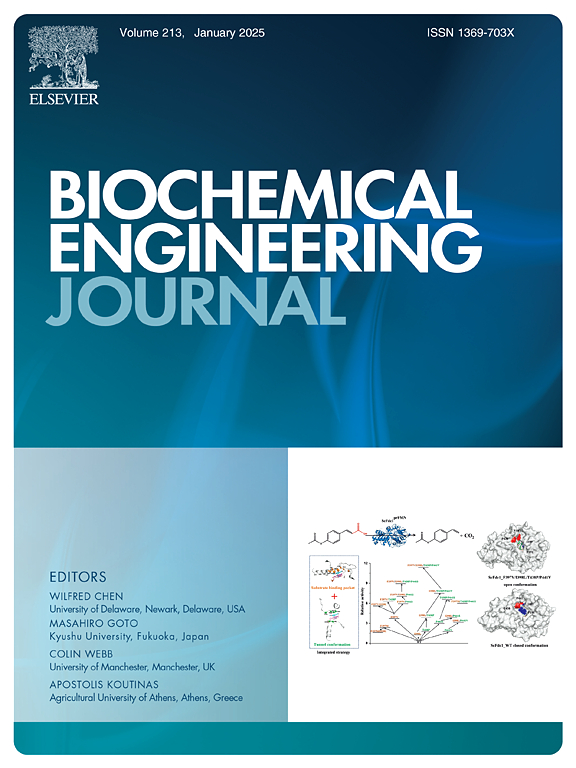Automated regression of bioreactor models using a Bayesian approach for parallel cultivations in robotic platforms
IF 3.7
3区 生物学
Q2 BIOTECHNOLOGY & APPLIED MICROBIOLOGY
引用次数: 0
Abstract
Mathematical models of bioreactors are powerful tools that aid in the analysis and prediction of process operation. However, the complex behavior of microorganisms makes modelling of biological processes a particularly challenging task, especially in the early developmental stages when data and knowledge are scarce. As a result, bioreactor models may perform poorly due to structural errors or high uncertainty in their parameterization. Here, we present a method for automated dynamic model regression based on a Bayesian approach that can be applied in the operation of laboratory robotic platforms to perform both parameter estimation and state predictions for a given experimental design. Starting with wide distributions over parameters (prior knowledge), the model is updated as new data is generated and is then used to predict the evolution of the experiment. The proposed method is tested with data from several parallel cultivations from a 24 mini-bioreactors platform containing an Escherichia coli strain operating in fed-batch mode. The results highlight both the versatility of the approach to estimate parameter distribution as well as to predict the state evolution.
在机器人平台上使用贝叶斯方法进行并行培养的生物反应器模型的自动回归
生物反应器的数学模型是分析和预测过程运行的有力工具。然而,微生物的复杂行为使得生物过程的建模成为一项特别具有挑战性的任务,特别是在数据和知识匮乏的早期发育阶段。因此,由于结构误差或参数化的高度不确定性,生物反应器模型可能表现不佳。在这里,我们提出了一种基于贝叶斯方法的自动动态模型回归方法,该方法可以应用于实验室机器人平台的运行,对给定的实验设计进行参数估计和状态预测。从参数(先验知识)的广泛分布开始,模型随着新数据的生成而更新,然后用于预测实验的演变。该方法通过24个微型生物反应器平台的平行培养数据进行了测试,该平台包含一种以间歇饲养模式运行的大肠杆菌菌株。结果显示了该方法在估计参数分布和预测状态演化方面的通用性。
本文章由计算机程序翻译,如有差异,请以英文原文为准。
求助全文
约1分钟内获得全文
求助全文
来源期刊

Biochemical Engineering Journal
工程技术-工程:化工
CiteScore
7.10
自引率
5.10%
发文量
380
审稿时长
34 days
期刊介绍:
The Biochemical Engineering Journal aims to promote progress in the crucial chemical engineering aspects of the development of biological processes associated with everything from raw materials preparation to product recovery relevant to industries as diverse as medical/healthcare, industrial biotechnology, and environmental biotechnology.
The Journal welcomes full length original research papers, short communications, and review papers* in the following research fields:
Biocatalysis (enzyme or microbial) and biotransformations, including immobilized biocatalyst preparation and kinetics
Biosensors and Biodevices including biofabrication and novel fuel cell development
Bioseparations including scale-up and protein refolding/renaturation
Environmental Bioengineering including bioconversion, bioremediation, and microbial fuel cells
Bioreactor Systems including characterization, optimization and scale-up
Bioresources and Biorefinery Engineering including biomass conversion, biofuels, bioenergy, and optimization
Industrial Biotechnology including specialty chemicals, platform chemicals and neutraceuticals
Biomaterials and Tissue Engineering including bioartificial organs, cell encapsulation, and controlled release
Cell Culture Engineering (plant, animal or insect cells) including viral vectors, monoclonal antibodies, recombinant proteins, vaccines, and secondary metabolites
Cell Therapies and Stem Cells including pluripotent, mesenchymal and hematopoietic stem cells; immunotherapies; tissue-specific differentiation; and cryopreservation
Metabolic Engineering, Systems and Synthetic Biology including OMICS, bioinformatics, in silico biology, and metabolic flux analysis
Protein Engineering including enzyme engineering and directed evolution.
 求助内容:
求助内容: 应助结果提醒方式:
应助结果提醒方式:


